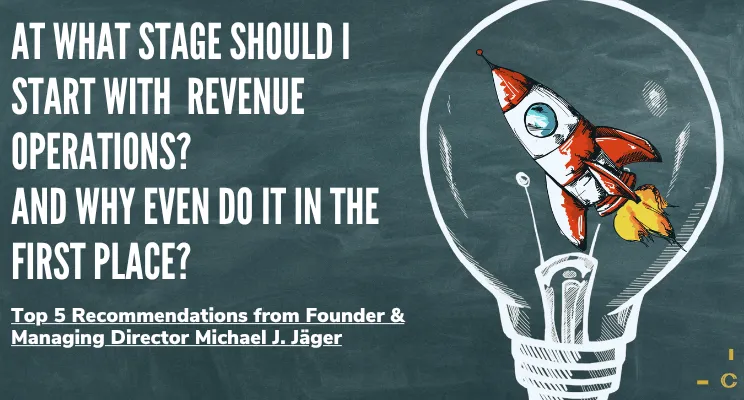.webp)

.gif)

Revenue Operations (RevOps) has become a cornerstone of modern business operations: no longer a nice-to-have, but a must-have. More and more founders and business leaders recognize the value of this approach and are actively restructuring their organizations to implement it.
Michael J. Jäger, Founder & Managing Director at Cremanski & Company, hears one question more than any other in client conversations:
“At what stage of my B2B SaaS startup should I start with Revenue Operations?”
In this article, Michael answers that question and shares his Top 5 recommendations for how to implement RevOps the right way, to set up structured, scalable, and sustainable growth.

So why all the buzz around RevOps?
In our article What Is Revenue Operations?, we explained why it’s worth rethinking your company’s structure from the ground up.
In short: a Revenue Operations team connects what used to be separate, departments, data, and processes. It eliminates silos and creates alignment across goals, priorities, and strategies company-wide.
As a strategic function, RevOps drives sustainable, structural growth by focusing on your company’s revenue architecture ensuring your:
work together seamlessly throughout the entire customer lifecycle.
The result? Measurable improvement in growth, collaboration, and efficiency.
Here’s what your business gains from implementing Revenue Operations:
Most founders and leadership teams feel when something needs to change. Pain points appear, coordination gets harder, and growth starts to slow.
If any of the following sound familiar, it’s time to consider implementing RevOps:
Theory is one thing, execution is another.
Here are Michael’s five practical recommendations to get started with RevOps the right way.
Start with clarity. Define your Go-to-Market model (GTM) and strategy with clear financial goals, KPIs, and structures that reflect your company’s current stage.
Your GTM model is the foundation on which all RevOps structures will be built.
Create a strategic and tactical RevOps role inside your organization and make sure it has a seat at the table.
Your VP of Revenue Operations should operate on the same level as the VP of Marketing, VP of Sales, and VP of Customer Success. That’s the only way RevOps can effectively connect and influence all commercial functions.
Map your full customer journey from first touch to renewal and expansion. Build a unified data model that spans all commercial teams, and integrate it into your systems and processes.
This is the backbone of operational alignment across the business.
Make sure these four RevOps functions are actively implemented and running:
Together, they form the operating system of your revenue engine.

RevOps only creates value when it has authority to act. Give your RevOps team the access and influence it needs to connect systems, teams, and processes.
That’s how you create true transparency, avoid data silos, and build a culture of process-driven, efficient collaboration.
Most B2B companies depend on recurring revenue which means growth doesn’t stop at the first deal.
In fact, real profit often comes at the back end of the customer lifecycle: in retention, expansion, and advocacy.
That’s why investing in Revenue Operations early isn’t a nice-to-have, it’s a competitive advantage.
Presenting our distinguished clientele! We collaborate closely with visionary B2B tech and software companies, intricately shaping their comprehensive Revenue Architecture. Take a look at who we have already served.

Explore our captivating customer success
stories here.


























































































You have questions? Our Founder and Managing
Partner Michael is looking forward to hearing from
you.